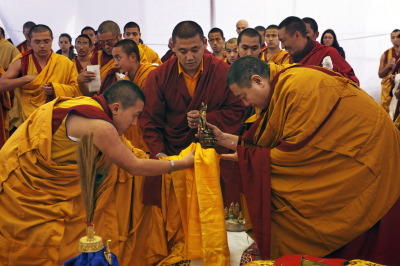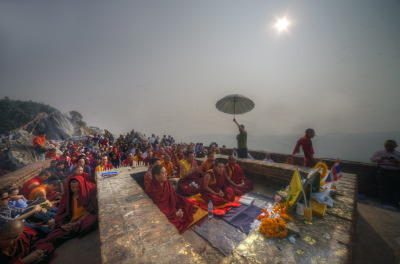Rajgir is the place where the Buddha taught the Transcendent Perfection of Wisdom (Prajna paramita), at the Vulture Peak, sixteen years after his enlightenment, to an assembly of 5,000 monks, nuns and laity, as well as innumerable bodhisattvas. This teaching is known as the second turning of the Wheel of Dharma and if focus on understanding the meaning of ‟emptiness”, sunyata, which is the ultimate nature of phenomena.
When Buddhism states that emptiness is the ultimate nature of things, it means that the things we see around us, the phenomena of our world lack any autonomous or permanent existence. But emptiness is not at all a void, or the absence of phenomena, as early western commentators of Buddhism once thought. Buddhism does not at all espouse any form of nihilism, or the belief in nothingness. Emptiness does not correspond to non-existence. If you can’t speak of real existence, you can’t speak of non-existence either. The Fundamental Treatise of the Perfection of Wisdom says: ‟Those who become fixed on emptiness are said to be incurable”. Why incurable? While a belief in the real existence of phenomena is dissipated by meditation on emptiness, if you get attached to emptiness itself, making it an object of your belief, you fall into nihilism. The same text therefore goes on: ‟Consequently the wise abide neither in Being nor Non-Being”.
According to Buddhism, learning to understand the essential unreality of things is an integral part of the spiritual way. Knowledge of our spirits and knowledge of the world are mutually enlightening and empowering. The ultimate aim of both is to dissipate suffering.
Rajgir is also the place where Sariputra and Maudgalyayana, the two foremost disciples of the Buddha embraced Buddhism, and where the Buddha tame a wild elephant.
King Ajatasatru possessed a ferocious elephant. Shakyamuni’s jealous cousin Devadatta, hearing that the Buddha was coming to Rajgir, arranged to have the elephant escape. As the Buddha came toward the city, Devadatta went to the palace terrace to see the Buddha killed, but when the elephant came rushing at the Buddha, the Enlightened One tamed the elephant with a few words, and the ferocious beast knelt at this feet.
In Rajgir, King Bimbisara offered the Veluvana Bamboo Grove to the followers of the Buddha. The site was ideal for a monastic order, being not too near the city, calm and having mild air and cool water. Thus it was suited to the practice of meditation, and here Shakyamuni passed the first rainy season retreat following his enlightenment. He was to return to this place for several rainy season retreats later in his life.
The final journey of Buddha’s life, which ended with the mahaparinirvana at Kushinagar began at Rajgir.
Shortly after this, the First Council—an assembly of 500 monks presided over by Buddha’s great disciple and spiritual heir Mahakashyapa—met under the patronage of King Ajatasatru in the Shrataparna Cave, near Veluvana Grove, and compiled all the Buddha’s teachings from memory. This is why all the sutras (the Buddha’s sermons) begin with the phrase ‟Thus I have heard, in such a place, at such a time..” It is said that the Buddha’s nephew Ananda, who accompanied the Buddha throughout his life and heard countless of his teachings was not supposed to attend the gathering, because he had not yet become a Arhat. As he spent all his time serving the Buddha, he could not engaged in sustained spiritual practice. But Ananda sat in one-pointed meditation throughout the night, and thanks to the vast store of merit he had accumulated by serving the Buddha faithfully, at dawn he attained arhatship and participated in the council.
 Dilgo Khyentse Rinpoche offers the symbols of enlightened body, speech and mind to Rabjam Rinpoche
Dilgo Khyentse Rinpoche offers the symbols of enlightened body, speech and mind to Rabjam Rinpoche Prayers on the top of the Vulture Peak
Prayers on the top of the Vulture Peak